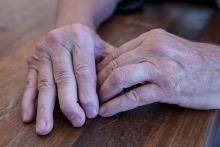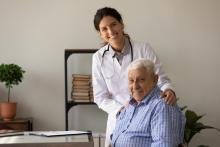Let's Talk about Lupus has proven to be a successful initiative in the field of patient education, in this video blog we will talk with Dr. Cristina Drenkard about this experience and recommendations to extend these initiatives at a regional level.
TRANSCRIPTION
EF: Hello everyone and welcome to a new Global Rheumatology video blog where we will be discussing different topics. We are here today with Dr. Cristina Drenkard, associate professor at Emory University in the United States and director of the Let's Talk about Lupus program. We will be talking about this program, about patient education and all this integration that is being done. Welcome, Doctor.
CD: Thank you very much, Estefania. I am very glad to be here with you and the Global Rheumatology audience.
EF: How did the education projects for lupus patients, specifically Let's Talk about Lupus, come about?
CD: Let’s Talk about Lupus came about because a group of doctors specialized in lupus saw an unmet need with regard to the education that patients living with this disease, and their families, receive or were receiving. This in relation to groups and specifically in Spanish which was one of the great deficits, most of the serious and reliable information existing up to that moment about lupus for patients was available in English or translated from English to Spanish, which is not adequate because people who speak English or who live in the United States or other countries have different needs, live under different circumstances, the health systems are different, and therefore their problems are different as well. So, being aware of this need, we decided to start with this task of educating the Latin American population with lupus.
EF: When did Let’s Talk about Lupus begin?
CD: We started in 2017 with the idea of providing reliable, easy to understand education, as I said before, to the Latin American population through social networks and a website in order to reach a large number of people. We know that there are many ways and channels to provide education, but our intention was precisely to reach as many people as possible and that is why in 2017, we launched the program first through Facebook and YouTube, to Twitter and later when Instagram became more popular, we also shared our content there. We also have the website that compiles a large amount of information very much adapted to the needs and language of the patients.
EF: Dr, what should be considered when developing this type of programs for patient education?
CD: Dialogue and communication between interested parties is essential, to have an interaction between scientists, technicians, doctors, and health professionals, but is also fundamental to include the patient, the person living with the disease, in order to be able to provide the information he/she may require according to his/her needs. Therefore, to be able to reach a consensus between these two very important parts in order to provide a product that really reaches people with reliable information, serious information, useful information, that is easy to digest, and that the audience really feels that it belongs to them, that it really meets their needs.
EF: Let's talk about best practices and those strategies that have been used throughout this time and the experience they brought you.
CD: It has really been a journey rich in experiences, in learning. We established a system in which the audience, the patients, their families, their friends, who visit Facebook and our social networks, can express themselves, can have a voice through these channels. The group of educators is also behind them, I mean, because we do not really act as doctors when we interact with the audience of Let's Talk about Lupus, we are educators. In the sense that we listen to the questions, the concerns, the worries of the audience and there is a team behind the scenes, so to speak, that is permanently giving an answer to the audience, giving them resources, providing information, to make this something interactive and personalized. Also, when we saw the great interest of the Latin American population with lupus in knowing more about the disease and how to deal with it, we started to do a monthly activity which are the live video chats with the experts. These are developed by inviting doctors with great experience in lupus or patient leaders who also have their voice in these video chats, and all this is broadcasted live through YouTube and Facebook, and then the audience has the possibility to listen to the experts, ask questions and receive the answers on the spot.
It is really an activity that has brought great satisfaction because people feel listened to and there is an immediate interaction, they do not have to wait for a response in a deferred time, so these are aspects that we have been developing throughout the program, learning a little about the patients' needs, about what they were asking for, in order to provide them with more resources.
Another example is a closed group that we created called “Let’s Talk about Lupus’ Friends”, which was created based on a survey we conducted a few months after starting the program, where many of those who answered the survey asked us to interact more among themselves, among patients, among peers, so, we decided to create this group, which is closed by invitation, where patients have their own space and can give each other emotional support, share experiences, give each other advice, and it is managed by a patient with wide experience, not only because of her experience with the disease, but also because she has received a lot of education about it. Her work is focus in balancing a little bit the interactions in the group and making sure that no information is transmitted or posted that could be negative for the audience.
EF: How does it work, what is the day-to-day work and structure, and what is the participation of educators and patients? Because we have already seen that there is a work that goes in synergy and in partnership.
CD: This is a learning-by-doing process. When we started there was a large volume of feedback by the audience, and we realized that we needed a team to be able to answer the large number of questions, so we called on rheumatologists with experience in lupus from our team, most of the teams are from the Latin American Lupus Study Group, or GLADEL group. We received a great response and we have a team of rheumatologists that answer the questions and they take turns, they communicate with each other so they can really answer all the questions. And they also received training so that the questions are answered in an objective way. We do not give consultation, we do not give specific recommendations about any treatment because it is not the interface where the patient should look for that, but rather we give objective information that can help the patient to better understand their problem and also give them tools so that they can better communicate with their doctor about their problem.
Therefore, the whole team that answers questions does it in an objective way providing general information and always advising the patient and, in a way, encouraging him to go to his doctor with this information and look for more answers, to look for specific answers on the other hand as well.
Also, because there were a large number of questions and answers, many questions are sometimes repeated because the audience is dynamic, it comes in, goes out, new followers, thus, we created a repository of questions and answers that are not very easy to answer right away, exact questions. So, it has really been a creative process of moving forward and learning as we go along.
EF: What are the main challenges, but also the advantages of these programs for patient education considering that we are now in a hyperconnected world where information comes from everywhere? How to address it so that patients have the right information at the right time?
CD: As you rightly say, the Internet and social networks have invaded us all, and within this universe of information that has really exploded, especially in the last few years since the pandemic, but even before - because we started before the pandemic - all this has its challenges and its risks, which must be taken into account both by the patients and by the doctors who are guiding our patients. And one of those great challenges is to learn to select and filter the information and we doctors have to do all of that, when we look for scientific information, we must also make a selection and filtering process, the same must be done by the patients in order to use only reliable information that can help them in their individual needs, otherwise they can be a victim of people who only look for personal or monetary benefit by promising false remedies, or magic remedies with false and expensive cures, which are really counterproductive.
That is why it is so important the selection process we make through the needs of the patients, are the patients themselves, with their questions and feedback, who guide us to what they need to know, whether they need more information about emotional problems, about what is a reactivation of inactive lupus, about what medications are used for the different manifestations, then based on all that we are reading and absorbing from the audience, we are giving answers and of course selected by rheumatologists with experience in lupus, so it is evidence-based information.
But what is essential from the treating doctor and the patient is communication between them, so that the doctor can also guide the patient on where to find, or which are reliable sources where he can find the necessary information for his specific problems, because it is also part of the treatment, not only giving medications, not only making the diagnosis based on the symptoms and manifestations that the patient has, but also guiding him in his process of informing himself and learning more about his disease. So, at that point, communication is extremely important, and much of that is what we try to do through Let's Talk about Lupus, to empower the patient so that when they ask a question in our program, our channels, we motivate them to talk about that topic with their doctors and thus really give a different role to the patient's needs, also in the office setting.
EF: Dr. What is next in this process, and do you think that all the progress you have made with Let’s Talk about Lupus could be extrapolated to another disease, to another type of rheumatic disease?
CD: It can definitely be extrapolated to any chronic disease and to rheumatic diseases. It requires a determined team of doctors and patients, who have a vocation for education and who define the objectives, the ways of developing the program. We went down this route of social networks, because as I said, we wanted to reach a large number of Latin American patients, but there are also other ways, there are patient associations that also work together with rheumatologists and there are in PANLAR, of course, they have been pioneers in the development of programs to empower and educate patients with different rheumatic diseases, so these are replicable programs that, of course, require an effort, but they are really gratified on a daily basis when we see the number of patients who feel that the information they receive is very useful and that this gives them a more solid base to be able to better manage their disease, that give them more tools for self-care.
And these are, perhaps, also the greatest challenges, that the information that the patient receives through these channels can be transferred to self-care, to make decisions as to what are the objectives to be improved and what to do to achieve these objectives, and this process is also a process of education and analysis in relation to the disease itself and how to manage it.
EF: Lastly, based on your experience with Let’s Talk about Lupus, what suggestions would you give to establish a program for patient education in our region? What advice would you give to your colleagues to move forward in this journey?
CD: I think it is important that doctors start to talk more with our patients about education, we need to stop seeing the patient as an outsider and give him/her the chance to become an real actor in his/her disease management process, and for that, the doctor who has to be the one who encourages and motivates the patient, and also has to be familiar with robust and reliable educational resources to pass on the patient, either in readings, or websites, or channels, through social networks, or specific events, programs through, for example, PANLAR, that every year at the Congress holds an event for patients and by patients, so that they become familiar with all these resources, reliable resources. Thus, doctors can channel patients to this network of resources.
There are also other tools that doctors can also use to empower patients in their self-management or self-care, and that is to define the treatment objectives in a shared manner. We can put aside that somewhat paternalistic attitude, which fortunately is becoming less and less common among doctors and make shared decisions. Consider the specific needs of the patient, the doctor’s experience and his scientific knowledge are extremely important to guide the objectives, but also the patient's needs, and with these two points of view, let us say, to reach a consensus and establish specific objectives.
In lupus, for example, to be more specific, the objective is to reduce the cutaneous flare ups, how do we do that? Defining whether all the necessary measures are being used to avoid exposure to the sun, for example, or whether the patient is taking the medication according to what was recommended, or whether there is a problem with any of the medications that needs to be discussed to see if any changes are needed. Establish an interaction, a dialogue through which the physician and patient participate as equals in decision making.
EF: Dr., thank you very much for being with us today and telling us about this experience with Let’s talk about Lupus we hope for it continuous success, that you keep educating many more patients and that this relationship continues to be, precisely as we said a few questions ago, a synergy between specialist and patient, and above all using social networks that have been a channel that allowed us to provide all this information.
CD: I thank you very much again, Estefania, and my warmest greetings to all the audience. I am at your disposal for anything you may need, Let's Talk about Lupus is there for everyone. Thank you very much.







